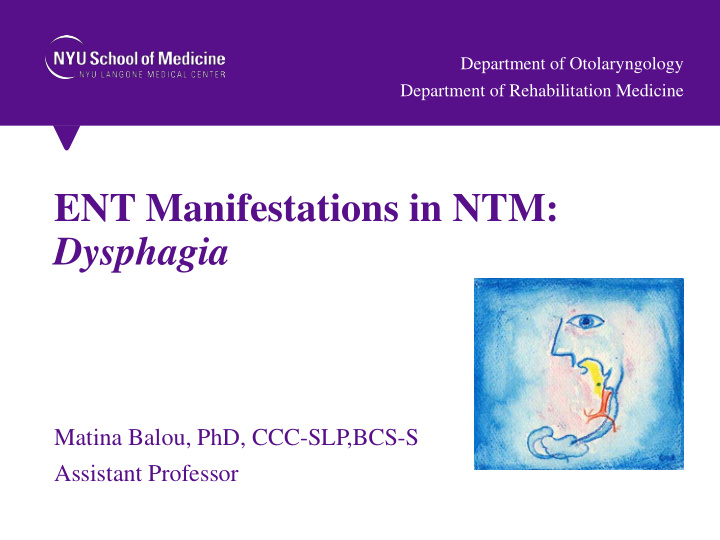



Department of Otolaryngology Department of Rehabilitation Medicine ENT Manifestations in NTM: Dysphagia Matina Balou, PhD, CCC-SLP,BCS-S Assistant Professor
Dysphagia = Δυσφαγία • Greek root phagein • Combined with prefix dys- • Final syllable ja • dis-FAY-juh 2
What is Dysphagia? • The term dysphagia refers to any difficulty moving food from the mouth to stomach. • It is a symptom of disease. • All age groups. • As a result of congenital abnormalities, structural damage and/or medical conditions. 3
Statistics… • Patients with respiratory disorders will often exhibit disorders of swallowing: • In a study of 78 patients with chronic obstructive pulmonary disease, it was observed that 85% of them had some degree of dysphagia. Good-Fratturelli, Curlee, & Holle, 2000 • Five studies reported that at least 80% of patients with COPD showed to have swallowing dysfunction O’Kane & Groher, 2009 4
Dysphagia and Pulmonary Disease • Chronic cough • Chronic bronchitis • Chronic obstructive pulmonary disease • Obstructive sleep apnea • Pneumonia • Lung cancer • Bronchiectasis and NTM???? 5
Pulmonary Disease and Swallow Physiology Relationship between breathing and swallowing: • Anatomical: brainstem • Anatomical: similar structures used for both upper airway maintenance and swallowing • Physiological: swallowing interrupts the cycle of respiration Does disordered respiration lead to disordered swallowing function? 6
Signs and Symptoms • Obvious difficulties • Pneumonia and respiratory infections • Weight loss • Patient complaints 7
Does dysphagia matters? • ASPIRATION PNEUMONIA!!!! • Quality of life 8
Normal Anatomy & Physiology 9
Normal Anatomy & Physiology View during Laryngoscopy View during Videofluoroscopy 10
Stages of Swallowing The act of swallowing function is described in 4 phases: • Oral preparatory phase • Oral phase • Pharyngeal phase • Esophageal phase 11
Respiratory defenses • The most highly recognized neural response involved in airway protection is coughing. • Coughing is a reflex-evoked modification of breathing pattern in response to airway irritation. 12
Pulmonary Disease and Swallowing • Respiratory rate may increase, altering coordination between the shared functions of the upper aerodigestive tract. • In pulmonary disease, respiratory demand increases. • Each swallow closes the respiratory system for 1 ‐ 2 seconds. • As the respiratory rate increases, it may affect swallowing. 13
Purposes of Swallow Study • Adequacy of airway protection. • Provide valuable information of anatomy and physiology. • Coordination of respiration and swallowing. • Patient’s ability to swallow various • Evaluate the impact of consistencies. compensatory strategies on • Assess secretions and patient’s physiology. reaction to them. • Comprehensive perspective on swallowing from the lips through the esophagus. 14
Treatment Planning The goal of any treatment program is the re- establishment of safe oral intake while maintaining adequate hydration and nutrition. What type of nutritional management is necessary? What type of therapy • Compensatory strategies or exercises? • Direct or indirect? 15
Current Research • Swallow studies were analyzed from 41 newly diagnosed patients with NTM. • Two swallows were analyzed per patient (N=164 swallows). • The primary outcome of interest was airway protection. • The proportion of subjects with at least one unsafe swallow was 41.5%. 16
Future Research • Future work should explore swallowing physiology in NTM population • Further work needs to determine the relationship between impaired swallowing safety and NTM progression. 17
Thank you
Recommend
More recommend